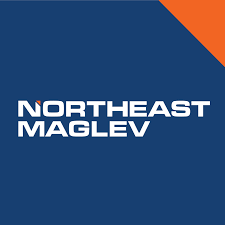History
In 2003, the Federal Railroad Administration (FRA) and the Maryland Transit Administration (MTA) prepared a Draft Environmental Impact Study (DEIS) on a proposal to build a maglev project linking downtown Baltimore to BWI Marshall Airport and Union Station in Washington, D.C. The project would have used Transrapid, a German maglev technology. An Environmental Impact Statement was prepared, but Maryland suspended the project and a final EIS was never issued. [5]
The Northeast Maglev, LLC, was founded on March 25, 2010, to promote a revived effort to bring a maglev train to the Northeast Corridor. [6] Baltimore-Washington Rapid Rail, LLC, was founded in October 2011 [7] and is the developer of the Northeast Maglev's first leg from Washington, D.C., to Baltimore.
In March 2015, the FRA issued notice of available funding under the Maglev Deployment Program (MDP). In April 2015, acting on behalf of Baltimore–Washington Rapid Rail (BWRR), the Maryland Department of Transportation (MDOT) submitted an application to FRA for the funds to perform preliminary engineering (PE) and National Environmental Policy Act (NEPA) work related to BWRR's SCMAGLEV proposal. [8]
In 2015, the Maryland Public Service Commission (PSC) approved BWRR's application to acquire a passenger railroad franchise abandoned in 1935 [9] by the Washington, Baltimore and Annapolis Electric Railroad Company. [10] The Maryland PSC found that "the construction and operation of the SCMAGLEV between Washington, DC and Baltimore will result in substantial economic and social benefits to the State (of Maryland) and Baltimore and be consistent with the State's environmental laws and policies enacted or adopted to reduce harmful emissions for cleaner air and address the causes of climate change," and that awarding a franchise to facilitate in development of the SCMAGLEV was "in the public convenience and necessity." [11]
In 2016, the FRA awarded $27.8 million to MDOT to prepare preliminary engineering and NEPA analysis for an SCMAGLEV train between Baltimore, MD, and Washington, DC, with an intermediate stop at Baltimore-Washington International (BWI) Airport. [12]
The FRA and the MDOT were preparing an Environmental Impact Statement (EIS) to evaluate the potential impacts of constructing and operating a high-speed superconducting magnetic levitation (SCMAGLEV) system between Washington, DC and Baltimore, Maryland with an intermediate stop at BWI Airport. That EIS was "temporarily" ceased, waiting for an "updated engineering input from Baltimore Washington Rapid Rail, the subsidiary of Baltimore-based Northeast Maglev" and the FRA citing "so that work does not have to be redone once the engineering inputs are finalized", in December 2019. [13] The EIS was being prepared in compliance with the National Environmental Policy Act of 1969 (NEPA), as amended, and other applicable regulations and procedures. Baltimore-Washington Rapid Rail is providing preliminary engineering and technical assistance as well as additional funding support, in concert with the FRA grant, for the NEPA process. [14]
In a Purpose and Need Statement, the NEPA Team for the SCMAGLEV Project, led by FRA and coordinated by MDOT, said the project's purpose was to increase capacity, reduce travel time, and improve both reliability and mobility options between Baltimore and Washington. "The population in the Baltimore-Washington area makes up one of the largest and densest population centers in the United States. Over the next 30 years the population in the area is projected to increase by approximately 30 percent. Similarly, the demand on the transportation infrastructure between Baltimore and Washington will continue to increase..." [15]
The project has received endorsements of support from organizations including North America's Building Trades Unions, [16] Greater Baltimore Urban League, [17] Maryland State Conference NAACP and four of its local branches, [18] and four Baltimore–Washington corridor chambers of commerce including Prince George's Chamber of Commerce, Northern Anne Arundel County Chamber of Commerce, Baltimore City Chamber of Commerce, and Baltimore County Chamber of Commerce. [19]
On June 9, 2020, it was released that Northeast Maglev and B&O Railroad Museum created an alliance to bring educational support to the museum. [20]
On August 1, 2025, the Trump administration halted its review of the project. The proposal would cause “significant, unresolvable impacts to federal agencies and federal property,” according to a letter the FRA sent Thursday to Maryland Transportation Secretary Paul Wiedefeld and shared with The Baltimore Banner. The letter also cites “substantial delay and cost overruns” associated with the review process. “This project did not have the means to go the distance, and I can’t in good conscience keep taxpayers on the hook for it,” U.S. Transportation Secretary Sean Duffy said in an emailed news release. [4]
